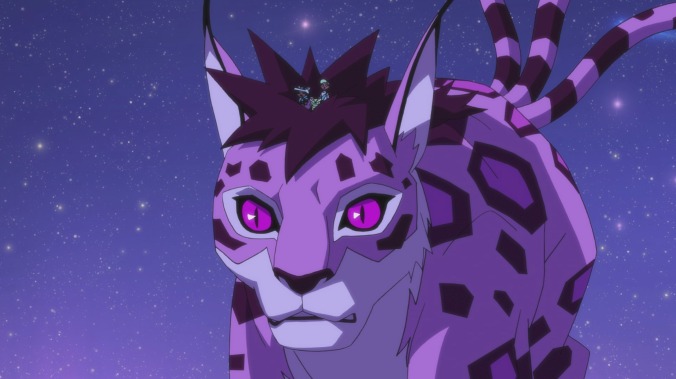In that case, it’s better to think of the animated Netflix wonder similarly to a lengthy film split into three hearty acts. In season (or act) one, Kipo (impeccable voiced by Karen Fukuhara) learns the ways of the surface world while searching for the giant mutated monkey that attacked her burrow and scattered her beloved community. When she discovers that the humans, including her father Lio (Sterling K. Brown) are being mind-controlled by the much maligned anthropomorphic mandrill Scarlemagne (Dan Stevens), Kipo sets out with Benson (Coy Stewart), Wolf (Sydney Mikayla), and Dave (Deon Cole) in season two to overthrow the dangerously resentful mutated primate (or “mutes” as all mutated beings are succinctly dubbed) and save humanity. This was also a time for Kipo to learn how to control the mutated genes that allowed her to morph into a formidable purple jaguar, and to unlock some secrets of the surface world, like the fact that the mega monkey was actually her seemingly perma-mutated mother, Song (Jee Young Han).
As Kipo’s third and final act, season three proves to be well worth the emotional investment that fans have made over the past 10 months since the show’s premiere. From the beginning, the creative team has not only built a bold playground rife with mystery and magic, but a roster of fully realized figures with their own separate journeys that exist outside of the chipper leader’s main narrative. This is a group—and a friendship—that will be sorely missed. At the same time, the creators make such great use of the time that they have that it’s hard to bid adieu while feeling too cheated. With raised stakes, excellent character growth, and some commendable (if not a touch heartbreaking) risk-taking, Kipo’s entire run makes one of the strongest cases for shorter, tightly rendered storytelling in television.
When we last left our adventurers, they had successfully dethroned Scarlemagne and were on the hunt for Dr. Emilia (Amy Landecker), the burrow’s former leading scientist who is steadily building a human following with the intent to eradicate all mutes from this world. While season two hinted toward the danger on the horizon, season three raises the stakes exponentially by presenting the bigoted researcher as the purveyor of life-or-death consequences. She’s also, in comparison to everyone we’ve met thus far, the toughest personality for Kipo to crack: In the two previous seasons, we’ve watched the precocious teen wield her friendly, engaging attitude to gain allyship. This time, viewers witness what happens when that strategy doesn’t exactly work, and it pushes both Kipo and the fans beyond their comfort zones in a way that is necessary. It’s part of what makes this 10-episode effort the most enthralling of the series: Dr. Emilia and all of the chaos in her wake are indicative of a creative team that isn’t afraid to take particularly big swings, especially in relation to the lengths that the evil scientist would go to establish human supremacy.
Her imposing presence this season also serves to essentially shift our perspective of Scarlemagne and his oppressive history. In comparison (and with lots of additional background for both characters between the second and third seasons), the mandrill’s previous attempts to reign seemingly stem from trauma whereas Dr. Emilia’s genocidal goals are solely a product of instilled, bigoted ideology. It’s a tight line to walk, as the last narrative anyone needs is one that excuses or humanizes an oppressor of any sort, especially in today’s toxic political climate. Laying down the groundwork for Scarlemagne’s redemptive arc in season two works to the writers’ advantage here as an early hint of his story’s innate complexity. Also, he’s never redeemed to the point of total absolution. Weaving the two antagonists’ stories the way that Kipo’s writers have—that is, positioning Dr. Emilia as one of Scarlemagne’s biggest childhood abusers—emphasizes the potency of early trauma, which is still a necessary story to tell against the mostly pleasant backdrop.
One of the most delightful developments, in fact, is this season’s meeting of the minds. As the doctor’s following grows, Kipo ventures to create an opposing alliance with the various mute communities she’s befriended on the surface. H.M.U.F.A—or the Human Mutant Ultimate Friendship Alliance—may not be the most unforeseen move, especially for the unrelentingly friendly protagonist. It is, however, rewarding to see the culmination of Kipo’s untethered imagination in one place. What’s more, mutant communities that were previously relegated to a few fleeting shots are granted more depth this time around, and new creatures feel like parting gifts, or further assurance that this world is far more vast and enchanting than we realize. These moments also double as trophies for the animators, who provide some of the most mesmerizing shots that we’ve seen throughout the series.
When it comes to exerting maximum effort for this final bow, the animators are joined by… well, everyone. The jokes are chiefly airtight thanks to both a sharp collective of writers and a cast capable of pitch-perfect delivery. (Stewart, Cole, Brown, and Mikayla hand over some of the biggest guttural laughs this round.) Composer Daniel Rojas outdoes himself with a vibrant seasonal soundtrack that defies genre and language. Season three prevails thanks in no small part to a production team that takes full advantage of a tale approaching its end. More importantly, it spares no moment of deep sentimentality and serious growth among every creature that we meet. As far as endings go, Kipo’s farewell is still a tinge bitter, but far more sweet.



 Keep scrolling for more great stories from A.V. Club.
Keep scrolling for more great stories from A.V. Club.